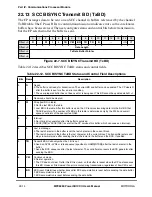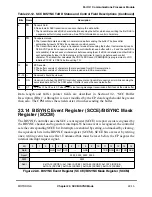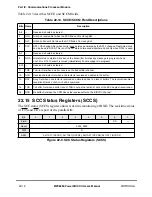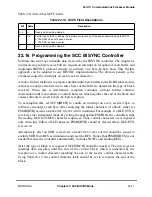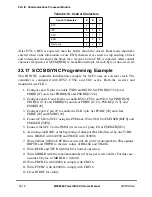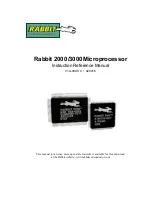
MOTOROLA
Chapter 22. SCC BISYNC Mode
22-3
Part IV. Communications Processor Module
If no additional buffers have been sent to the controller for transmission, an in-frame
underrun is detected and the controller starts sending syncs or idles. If the controller is in
transparent mode, it sends DLE-sync pairs. Characters are included in the block check
sequence (BCS) calculation on a per-buffer basis. Each buffer can be programmed
independently to be included or excluded from the BCS calculation; thus, excluded
characters must reside in a separate buffer. The controller can reset the BCS generator
before sending a speciÞc buffer. In transparent mode, the controller inserts a DLE before
sending a DLE character, so that only one DLE is used in the calculation.
22.3 SCC BISYNC Channel Frame Reception
Although the receiver is designed to work with almost no core intervention, the user can
intervene on a per-byte basis if necessary. The receiver performs CRC16, longitudinal
(LRC) or vertical redundancy (VRC) checking, sync stripping in normal mode, DLE-sync
stripping, stripping of the Þrst DLE in DLE-DLE pairs in transparent mode, and control
character recognition. Control characters are discussed in Section 22.6, ÒSCC BISYNC
Control Character Recognition.Ó
When enabled, the receiver enters hunt mode where the data is shifted into the receiver shift
register one bit at a time and the contents of the shift register are compared to the contents
of DSR[SYN1, SYN2]. If the two are unequal, the next bit is shifted in and the comparison
is repeated. When registers match, hunt mode is terminated and character assembly begins.
The controller is character-synchronized and performs SYNC stripping and message
reception. It reverts to hunt mode when it receives an
ENTER
HUNT
MODE
command, an error
condition, or an appropriate control character.
When receiving data, the controller updates the BCS bit in the BD for each byte transferred.
When the buffer is full, the controller clears the E bit in the BD and generates an interrupt
if the I bit in the BD is set. If incoming data exceeds the buffer length, the controller fetches
the next BD; if E is zero, reception continues to its buffer.
When a BCS is received, it is checked and written to the buffer. The BISYNC controller
sets the last bit, writes the message status bits into the BD, clears the E bit, and then
generates a maskable interrupt, indicating that a block of data was received and is in
memory. The BCS calculations do not include SYNCs (in nontransparent mode) or DLE-
SYNC pairs (in transparent mode).
Note that GSMR_H[RFW] should be set for an 8-bit-wide receive FIFO for the BISYNC
receiver. See Section 19.1.1, ÒThe General SCC Mode Registers (GSMR1ÐGSMR4).Ó
22.4 SCC BISYNC Parameter RAM
For BISYNC mode, the protocol-speciÞc area of the SCC parameter RAM is mapped as in
Table 22-1.
Summary of Contents for MPC8260 PowerQUICC II
Page 1: ...MPC8260UM D 4 1999 Rev 0 MPC8260 PowerQUICC II UserÕs Manual ª ª ...
Page 66: ...lxvi MPC8260 PowerQUICC II UserÕs Manual MOTOROLA ...
Page 88: ...1 18 MPC8260 PowerQUICC II UserÕs Manual MOTOROLA Part I Overview ...
Page 120: ...2 32 MPC8260 PowerQUICC II UserÕs Manual MOTOROLA Part I Overview ...
Page 138: ...Part II iv MPC8260 PowerQUICC II UserÕs Manual MOTOROLA Part II Configuration and Reset ...
Page 184: ...4 46 MPC8260 PowerQUICC II UserÕs Manual MOTOROLA Part II ConÞguration and Reset ...
Page 202: ...Part III vi MPC8260 PowerQUICC II UserÕs Manual MOTOROLA Part III The Hardware Interface ...
Page 266: ...8 34 MPC8260 PowerQUICC II UserÕs Manual MOTOROLA Part III The Hardware Interface ...
Page 382: ...10 106 MPC8260 PowerQUICC II UserÕs Manual MOTOROLA Part III The Hardware Interface ...
Page 392: ...11 10 MPC8260 PowerQUICC II UserÕs Manual MOTOROLA Part III The Hardware Interface ...
Page 430: ...Part IV viii MOTOROLA Part IV Communications Processor Module ...
Page 490: ...14 36 MPC8260 PowerQUICC II UserÕs Manual MOTOROLA Part IV Communications Processor Module ...
Page 524: ...17 10 MPC8260 PowerQUICC II UserÕs Manual MOTOROLA Part IV Communications Processor Module ...
Page 556: ...18 32 MPC8260 PowerQUICC II UserÕs Manual MOTOROLA Part IV Communications Processor Module ...
Page 584: ...19 28 MPC8260 PowerQUICC II UserÕs Manual MOTOROLA Part IV Communications Processor Module ...
Page 632: ...21 24 MPC8260 PowerQUICC II UserÕs Manual MOTOROLA Part IV Communications Processor Module ...
Page 652: ...22 20 MPC8260 PowerQUICC II UserÕs Manual MOTOROLA Part IV Communications Processor Module ...
Page 668: ...23 16 MPC8260 PowerQUICC II UserÕs Manual MOTOROLA Part IV Communications Processor Module ...
Page 758: ...27 28 MPC8260 PowerQUICC II UserÕs Manual MOTOROLA Part IV Communications Processor Module ...
Page 780: ...28 22 MPC8260 PowerQUICC II UserÕs Manual MOTOROLA Part IV Communications Processor Module ...
Page 874: ...29 94 MPC8260 PowerQUICC II UserÕs Manual MOTOROLA Part IV Communications Processor Module ...
Page 920: ...31 18 MPC8260 PowerQUICC II UserÕs Manual MOTOROLA Part IV Communications Processor Module ...
Page 980: ...A 4 MPC8260 PowerQUICC II UserÕs Manual MOTOROLA Appendixes ...
Page 1002: ...Index 22 MPC8260 PowerQUICC II UserÕs Manual MOTOROLA INDEX ...
Page 1006: ......


























